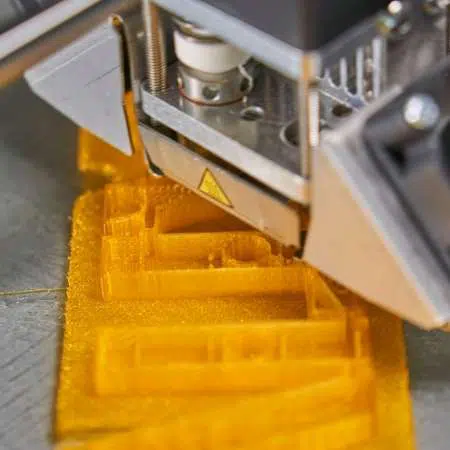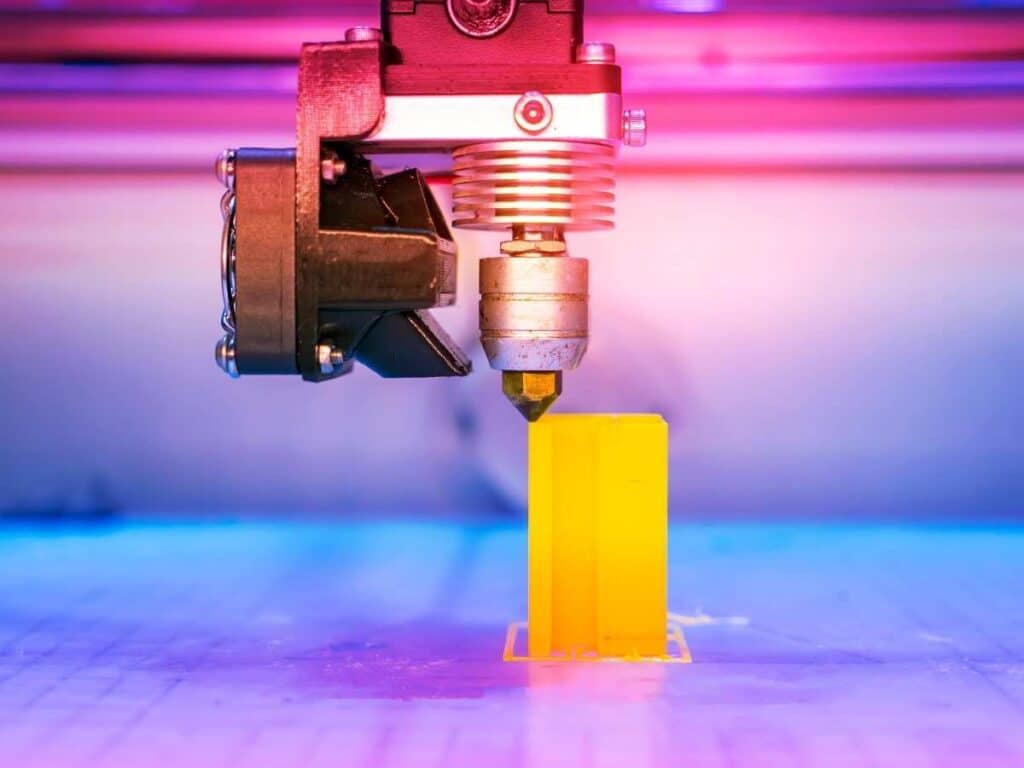A 3D printer oozing before it prints is an all-too-common (and frustrating) scenario for many owners. Also known as over extrusion, it occurs due to a variety of causes.
A 3D printer oozes before it prints because of low flow settings, high temperatures, and wrong filament diameter. It’s also caused by incorrect printing speed and retraction issues. You may rectify this by adjusting flow and temperature. Changing the filament diameter or print speed also works.
Below, I’ll describe these causes in detail – and what you may do to avoid them. That way, you don’t have to waste material over blobs, strung, or dimensionally inaccurate outputs.
5 Causes of a 3d Printer Oozing Before it Prints and How To Fix It
There are several reasons why your 3D printer is oozing before printing, so determining the exact issue may come with some trial and error. Luckily, no matter the cause, there’s an easy solution.
- Low Flow Setting
The extrusion multiplier, also known as the flow setting, determines the rate at which your printer squeezes out the filament. The default setting is 1 or 100%.
Should the nozzle release too much material, it can cause your device to ooze before printing.
The Fix: Low Flow Setting
Try to lower the flow by 2.5% decrements. This should stop the printer from producing excess material.
If this doesn’t seem to work after several adjustments, then check for the other possible causes below.
- High Printing Temperature
Print temperature refers to the setting that turns filament into a substance that the printer can extrude.
Since filaments have different chemical properties, the temperature, for say, Polylactic Acid (PLA), may not be applicable for Acrylonitrile Butadiene Styrene (ABS).
In other words, if the temperature is too hot for the filament you’re using, you can expect the printer to ooze before it even starts.
The Fix: High Printing Temperature
You should decrease the temperature by 5-degree points until there is no more oozing.
It would also help to print a temperature tower, as this can test the effect of each setting on the filament.
To avoid oozing, make sure to set the print temperatures as recommended:

PLA: It should be set to 180C to 230C or 356F to 446F. However, PLA is best printed at a temperature of about 210C or 410F.
While it doesn’t need a heated bed, you can still work with it if your printer has one. However, you will need to set the temperature to a lower range – 20C to 60C or 68F to 140F.
For best results, make sure to keep the cooling fans on when you print PLA.
ABS: This requires a temperature range of 210C to 250C or 410F to 482F.
If you’re using a heated bed, you should keep the temperature to 80C to 110C or 176F to 230F.
Compared to PLA, you should turn your cooling fans off when printing with ABS. Likewise, you should print this filament in an enclosed printer as this will help cool the material slowly.
Polyethylene Terephthalate Glycol: PETG requires a temperature of 220C to 250C. This is equivalent to 428F to 482F.
On the other hand, the heated bed should be set to 50C to 75C or 122F to 167F.
Nylon: This requires a temperature of 240C to 260C (464F to 500F) to print well. The heated bed temperature should be set to 70C to 100C (158F to 212F.)
Thermoplastic Urethane: TPU is a flexible filament that requires a temperature of 210C to 230C or 410F to 446F. The recommended heated bed temperature is 30C to 60C or 86F to 140F.
- Wrong Filament Diameter
The standard filament diameters are 1.75 mm (0.06 in), 2.85 mm (0.11 in), and 3 mm (0.11 in). Should you set a smaller diameter to what you’re using, the print will extrude the material at a higher rate.
As a result, your printer will ooze right before it starts working.
The Fix: Wrong Filament Diameter
It’s as simple as setting the correct filament diameter before you use your printer. That way, it won’t ooze and only extrude the necessary material.
When it comes to 3D printing, it’s crucial to find the optimal speed.
A slow-moving printer will mean more material will spurt out of the nozzle. On the other hand, a faster printer will mean that the filament has less time to exit the nozzle.
Either way, any of this will lead to oozing before your printer starts.
The Fix: Fast 3D Printing Speed
You should set the right printer speed, which is 190 to 200 mm/second.
When doing so, you need to make sure that the temperature is not so low.
That’s because when you increase the print speed – while the printer has a low temperature – you will encounter another problem: under extrusion. This means that there is not enough time for the filament to drip.
- Retraction Problems
Retraction is a 3D printer feature that governs two things: the filament amount released and the speed with which the nozzle recoils.
In other words, it makes the nozzle ‘retract’ once the set amount of filament is extruded.
Several retraction problems can lead to oozing or stringing, where small plastic strings appear on the finished product. This happens because:
- The extruder moves from one place to another, resulting in unintentional oozing.
- The retraction distance is incorrect, so the nozzle cannot pull some of the filament material back.
- The nozzle speed is not optimal.
The Fix: Retraction Problems
To prevent retraction-related oozing, you need to set the correct settings beforehand:
- Adjust the retraction distance. The most common retraction distance recommended is 0.5 mm (0.01 in) to 2 mm (0.07 in). You may have to set a bigger distance, especially if you’re using a Bowden-type extruder. In some instances, you may need to set a distance of as much as 15mm (0.59 in).
- Manipulate retraction speed. You need to set the speed accordingly before you use your printer. If it’s too slow, the plastic will leave the nozzle later than intended. A fast nozzle, on the other hand, will only bounce the filament off the hot plastic. Set your speed into the ‘sweet spot’ of 1200 to 6000 mm/minute or 20 to 100 mm/second.
Summary
A 3D printer oozes before printing because of several reasons.
The flow setting may be low, which you then should increase. In the case of high temperatures, it should be lowered in 5-degree decrements.
The same effect can also be caused by speed, which you will need to adjust accordingly. It would help if you also corrected the wrong filament diameter as this will prevent oozing.
Likewise, you should set the retraction distance and speed according to the material used.
- Written by:
- Ben
- Last updated:
- 11/16/2023
About Ben
I started 3D printing since 2013 and have learned a lot since then. Because of this I want to share my knowledge of what I have learned in the past years with the community. Currently I own 2 Bambulab X1 Carbon, Prusa SL1S and a Prusa MK3S+. Hope you learn something from my blog after my years of experience in 3D printing.

